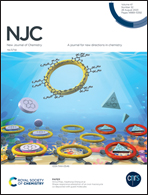Double charge transfer mechanistic insights into the tailoring of BiOI nanoplates and boron-doped graphitic carbon nitride: a 2D/2D anchored p–n heterojunction nanocatalyst for improved photodegradation†
Abstract
As we approach the new millennium, there is growing debate concerning the usage of antibiotics as growth promoters for animals due to worries that this practice may be hastening the development of resistance in human infections. This work aims to combat tetracycline hydrochloride (TCH) resistance in opportunistic, pathogenic, and commensal bacterial genes, which is a matter of grave consequence for the upcoming generations. Herein, the anticipation of the alignment of the band levels between both the precursors, boron-doped graphitic carbon nitride (BCN) and bismuth oxyiodide (BiOI), for the establishment of a photoactive 2D/2D p–n heterojunction is a notable objective of this work. The enhancement in the photoactivity of the fabricated BiOI/BCN-x nanocomposite has further been proved by the degradation of numerous kinds of dyes. Moreover, this work highlights the mechanistic comprehension of the double-charged migration responsible for the heterojunction conjunction, which has been reported in very few works of literature so far. It might be possible to comprehend the mechanism of degradation in upcoming forms of nanocomposite synthesis by including semiconductor work functions and vacuum-level band alignments. The kinetic rate constants and various characterizations of the prepared nanocomposite heterojunction give confirmatory evidence of enhancement in photoactivity by a significant (four-time) proportion (22.72% to 87.45%) than individual moieties, within a time period of 60 min duration. The enhanced photocatalytic efficiency has been attributed to the doping of the element boron as well as the combined effects of the two precursors. The recyclability study verifies its potential for environmental applications, paving the way for more scope through the further improvisation of the fabricated p–n heterojunction.



 Please wait while we load your content...
Please wait while we load your content...